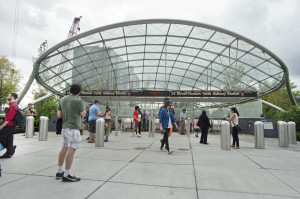 With an already completed, and beautifully designed Subway stop on the 7 train, the area along Manhattan’s 34th Street, between 10th and 11th Avenues, feels more real than ever before. Dubbed by developers as Hudson Yards, the forgotten space from which one can view Jersey and the namesake Hudson River, is said to be the largest private real estate development project in the country’s history at 17 million square feet of mixed use space, including shops, restaurants, office towers and approximately 5,000 residences. That’s quite a lot for a development that almost wasn’t.
With an already completed, and beautifully designed Subway stop on the 7 train, the area along Manhattan’s 34th Street, between 10th and 11th Avenues, feels more real than ever before. Dubbed by developers as Hudson Yards, the forgotten space from which one can view Jersey and the namesake Hudson River, is said to be the largest private real estate development project in the country’s history at 17 million square feet of mixed use space, including shops, restaurants, office towers and approximately 5,000 residences. That’s quite a lot for a development that almost wasn’t.
According to Fortune magazine, ideas for development in the area date back to nearly 60 years, more than a half-century ago, where real estate developer William Zeckendorf, Sr., known as the owner of New York’s famous Chrysler Building as well as the Hotel Astor in Times Square, among many other things, had dreams of building the world’s tallest skyscraper on the land (prior to the Willis Tower, the Burj Khalifa and the like). The pricey idea never materialized, and has since remained a rail yard with suggestions and proposals for development ever so often, including a site for the 2012 Olympics, a bid which New York City lost.
Nevertheless, plans continued and reality of the project can be seen. Sleighted to be a city within a city, the project will be constructed on stilts, because of a lack of space on Manhattan’s small island and to support the massive skyscrapers which will inhabit the area. The engineering for the project is complex and will undoubtedly be innovative, as with most of the city’s design and accomplishments to date.
As far as who will inhabit all this “city”, one of the more recent, high profile clients to claim hold is the San Francisco-based Wells Fargo Bank. By 2020, the bank is said to move from its current offices on 42nd Street to Hudson Yards, upgrading from 327,000 square feet to 500,000. News that developers secured $5 billion dollars in financing to build one of its largest towers came soon after. Considering the historic nature of the project and the opportunities therein, such a move could be incredible for the bank.
Wells Fargo isn’t the only company calling dibs in the area. It’s reported that both Neiman Marcus and Time Warner will be making home along the Hudson as well. In addition to the nearby Jacob Javits Convention Center, parks, restaurants and a public school, this area may very well define Manhattan and New York City in a couple of years, similar to the way Times Square does now, and at a just one stop away on the Subway, that idea may not be as far fetched as it sounds.
Developers estimate that nearly 24 million of NYC’s 56 million tourists (as of 2014) will visit the area annually. Diversifying what there is to see and do in the city is a progressive move, in an era of increasing globalization and development internationally. Another benefit of the project is the jobs it will create and likely inspiration to develop elsewhere. It will be interesting to see how it all unfolds over the next years. It’s about time.